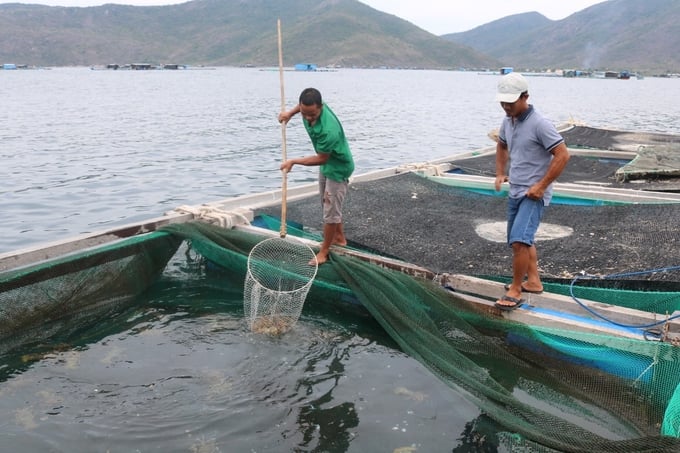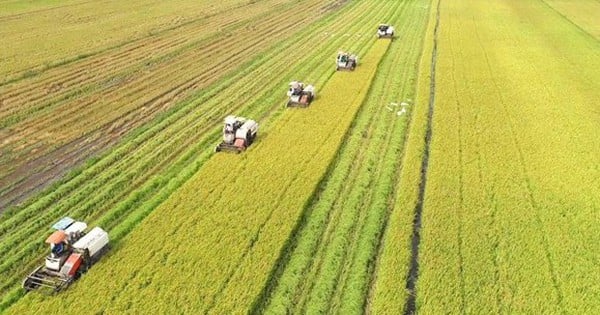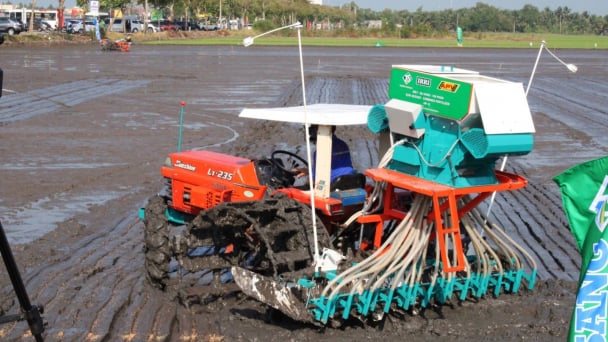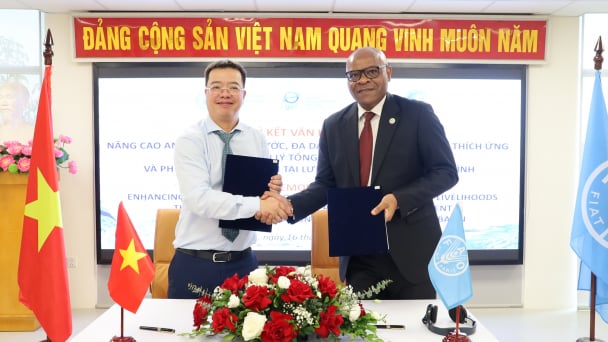May 19, 2025 | 23:36 GMT +7
May 19, 2025 | 23:36 GMT +7
Hotline: 0913.378.918
May 19, 2025 | 23:36 GMT +7
Hotline: 0913.378.918

Marine farming in Van Phong Bay. Photo: Kim So.
Standing amidst the marine farming expanse of Van Phong Bay in Van Ninh district, Khanh Hoa province, Mr. Vo Van Thai of the Van Phong Aquaculture - Tourism Cooperative expresses his frustration: They say disasters have no end, but for the seafarers of Van Ninh, the current situation feels like an endless onslaught. Market prices are plummeting, epidemics are rampant, and all the family's finances are invested into sea farming, yet uncertainty looms over the future of their livelihoods.
Van Ninh stands as one of the marine farming hubs in Khanh Hoa province, alongside Cam Lam, Ninh Hoa town, Nha Trang city, and Cam Ranh city. Marine farming emerged here around 1993, spurred by the movement to cultivate lobsters and other economically valuable marine species.
Local residents, as well as migrants from Phu Yen and Ninh Thuan, rushed to join the marine farming endeavor in Van Ninh. Before 2015, Van Ninh's marine farming activities were primarily concentrated in the Co Co Creek area, the eastern regions of Hon Vung - Hon Bip - Hon Mao islands, and the coastal areas of Xuan Tu, spanning over 1,134 hectares, predominantly relying on spontaneous farming.

With consecutive failures, marine farmers in Van Phong neglected their cages. Photo: Kim So.
Vo Van Thai, a seasoned "old fisherman," has traversed the waters of Van Phong Bay for over two decades. He has witnessed the evolution of marine farming, from its communal roots to the gradual encroachment of commercial enterprises, leading to the dwindling space for traditional farmers.
In 2018, as per the Fisheries Development Plan of Khanh Hoa province, Van Ninh district was allocated only six permitted farming areas covering 550 hectares. By 2022, this allocation will be further reduced to four areas, with a mere 350 hectares designated for farming in Ran Trao, Hon Vung, Co Co Cape, and Bai Nam. Despite this, according to Van Ninh district statistics, by the end of 2023, the district will boast approximately 1,352 farming households with over 1,848 rafts and nearly 3,000 workers, primarily engaged in lobster, sea fish, and oyster cultivation.
"Why remain uncertain about victory or defeat? Do you think transitioning from a large house to a small one is simple?" With a single poignant remark, Mr. Thai encapsulates the plight of marine farmers in Van Ninh district. Following the prosperous era of its inception, lobster farming in Van Ninh has faced dire challenges over the past 3-4 years.
Presently, the market price for lobster hovers around 600,000 VND/kg, while the expenses for seeds and feed alone exceed 800,000 VND/fish. Thirty-four members of the Van Phong cooperative find themselves ensnared in financial losses. Moreover, the bay's water quality has deteriorated due to overcrowding, exacerbating the spread of "black gill" disease, resulting in substantial losses for lobster farmers, leaving many in crippling debt.
Despite acknowledging the inherent risks of marine farming, locals are troubled by the uncertainty surrounding Van Ninh's future. As per the planned reductions, the dwindling farming areas and approximately 1,696 marine farming rafts operating outside the designated zones intensify the predicament. The issue is compounded by overlapping farming areas, where some individuals encroach upon territories licensed to marine farming businesses by the Provincial People's Committee.
While the state advocates offshore marine farming, the ambiguity surrounding initiation points and licensing procedures persists, adding to the community's woes.

The uncertainty looming over Van Phong Bay leaves its seafarers adrift, unsure of their future paths. Photo: Kim So.
"For us in the Van Phong Cooperative, without a marine farming license, we are at a standstill," members assert. The absence of allocated water surfaces deprives them of the foundation for establishing farming area codes, a prerequisite for export businesses. Moreover, substantial capital investment is requisite for marine farming, and the prospect of potential government eviction raises profound concerns—where would they relocate, or would they be compelled to drag their cages ashore?
Voicing these concerns to Mr. Nguyen Ngoc Y, Head of the Van Ninh district Economic Department, elicited further reflections. He acknowledged that marine farming in Van Phong Bay constitutes the primary livelihood for fishermen in the district, making planning, licensing, and transitioning support intricate matters.
"The primary challenge lies in the absence of clear coordinates and boundary demarcations in Khanh Hoa province's planning for 2021-2030, with a vision extending to 2050. Additionally, the proposal for a pilot project to develop high-tech marine farming in Khanh Hoa awaits approval from the Central Government. With multiple ministries and branches involved, the local authorities lack the groundwork to offer guidance," Mr. Y elaborated.
These descriptors encapsulate the task entrusted to the Khanh Hoa Provincial Party Committee as they endeavor to pioneer the development of high-tech marine farming in the province.
Blessed with a coastline stretching 385 km, dotted with over 200 islands of varying sizes, along with numerous lagoons and sheltered bays, Khanh Hoa holds abundant potential for marine farming. The province sets ambitious targets for a marine farming area of approximately 1.1 thousand hectares, a production output of around 15 thousand tons, and an export value totaling $725 million by 2025.
Since assuming the responsibility bestowed by the Central Government to spearhead the high-tech marine farming pilot project, Khanh Hoa's entire political apparatus has rallied to craft a comprehensive blueprint. Yet, the journey has been fraught with myriad obstacles.

Industrial-scale marine farming in Van Phong Bay. Photo: Kim So.
In September 2022, the Department of Agriculture and Rural Development of Khanh Hoa province, in collaboration with Aquaculture Research Institute III, convened a conference involving 19 agencies, management units, 8 scientific research entities, universities, 7 businesses, 4 associations, foundations, and over 30 specialized scientists.
The paramount challenge facing Khanh Hoa today remains its planning process. Preliminary assessments indicate that devising a pilot project for the high-tech marine farming development in Khanh Hoa entails navigating through the complexities of nine ministries and branches before seeking Government approval. Moreover, the implementation process must align with Khanh Hoa Provincial Planning for 2021-2030, extending to 2050, and the Project for Adjusting the general planning for constructing the Van Phong Economic Zone until 2040, with a vision towards 2050.
Mr. Nguyen Duy Quang, Director of the Department of Agriculture and Rural Development of Khanh Hoa province, disclosed that Khanh Hoa currently boasts over 4,000 hectares of brackish water marine aquaculture, with plans underway for more than 2,700 hectares of high-tech marine aquaculture. Additionally, Khanh Hoa stands as the pioneering destination for successful seafaring investments in Van Phong Bay, exemplified by the seabass farming model of Australis Vietnam Seafood Company Limited, the High-Tech Marine Farming Center model for yellowfin bird fish farming, and the Phuong Minh Aquaculture Joint Stock Company model.
Despite formulating a strategy and policy for marine farming geared towards offshore farming, Khanh Hoa awaits approval from the Central Government. Consequently, a bottleneck ensues: the province awaits the Central Government, and businesses await the province's initiatives, perpetuating the challenges within Khanh Hoa's sea farming sector. A striking example is the plight of the High-Tech Marine Farming Center under Aquaculture Research Institute I.

Sea farming model of the High-tech Sea Farming Center under the Aquaculture Research Institute I. Photo: Kim So.
Since 2013, this center has operated as one of Khanh Hoa's pioneering industrial-scale sea farming models, spanning over 10 hectares in Van Phong Bay. Equipped with 20 round HDPE cages utilizing closed Norwegian technology, each cage measuring 60m in circumference, the center primarily focuses on commercial yellowfin pompano cultivation. It's the country's first industrial yellowfin pompano farming model recognized for meeting VietGAP standards.
However, since October 2020, despite multiple applications to extend the water surface license, the center has been awaiting approval from the People's Committee of Khanh Hoa province, entangled in the plans of Van Phong Economic Zone and various other administrative schemes. Similar predicaments plague several businesses investing in industrial-scale sea farming in Khanh Hoa.
Mr. Pham Duc Phuong, Director of the High-Tech Marine Farming Center, emphasizes the urgency of early planning and clear licensing to mitigate the escalating consequences of sea farming in Van Phong Bay. The unregulated and haphazard sea farming practices have already triggered environmental and water quality repercussions, rendering sea farming infeasible in certain areas. Moreover, transitioning to offshore sea farming necessitates substantial capital and high-tech solutions, exacerbating the existing challenges.
Information from the Department of Agriculture and Rural Development of Khanh Hoa province underscores the significance of marine farming. It sustains approximately 74.55 thousand marine cages, predominantly for lobster and fish cultivation, with an estimated annual output of 10,000 tons. It provides employment for over 4,000 rural workers and contributes to about one-fifth of the fisheries sector's production value in the entire province. Nonetheless, Khanh Hoa's marine farming strategy faces formidable hurdles in reorganizing the industry and implementing transition policies.
Translated by Quynh Chi

(VAN) This was the assessment shared by experts at the workshop titled 'Assessing the Role and Potential of Low-Emission Rice Production Systems in Vietnam,' held on the morning of May 19.

(VAN) Cai Rong Port is the fisheries control center of Quang Ninh, helping to monitor fishing vessels, combat IUU fishing, and remove the EC's 'yellow card'.

(VAN) The German Agricultural Society (DLG) explores the possibility of establishing a mechanization service center in Vietnam’s Mekong Delta to support farmers in accessing and utilizing advanced machinery.

(VAN) On May 16, the Department of Water Resources Management, in collaboration with the Food and Agriculture Organization of the United Nations (FAO), held a signing ceremony for the GEF-8 project document.

(VAN) Food safety, mechanization, vocational training, and market opening are key areas of cooperation expected between the Vietnamese Government and the Federal Republic of Germany.

(VAN) Deputy Minister Nguyen Quoc Tri also expressed his hope that Cuba will soon overcome its current challenges, attain food security, and further expand cooperation with Vietnam.

(VAN) The project contributes to enhancing the resilience of communities vulnerable to the impacts of climate change, with a primary focus on local women.